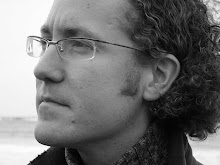The BBC Breakfast pieces can me seen here (it starts 15:22s):
http://www.bbc.co.uk/news/12550706
The clip they chose to feature was not included in my earlier discussion. It is very interesting from the eye movement perspective because it shows how our attention picks out motion and tracks it even when it is momentarily out of view. For instance, when the shot begins the viewers do not know what they are looking at so their gaze defaults to screen centre and the vanishing point of the train tracks.
The sound of a car's engine and the slight motion in the distance captures viewer attention and everybody looks in the same place.

As the camera pans right the viewers continue tracking the car. Because the car and the camera are both moving this means that the viewer's eyes may actually be stationary on the screen but they perceive the car as moving. In the real-world we would either pursue the car by rotating our eyes with it or rotate our head to keep the car at the centre of our gaze without moving our eyes. The pan in this example serves the same purpose as a head rotation.
As the car disappears behind the building the fact that the camera continues to move with the car and we hear the car's engine implies that it will reappear. Viewers try to find the car by saccading to the screen edge in anticipation of the car's reappearance.
Whenever a door or window appears in the building all viewers zoom in on it trying to catch a glimpse of the car. This high degree of attentional synchrony is expressed by the heatmap that appears periodically during the clip. If you want to know more about how this heatmap is calculated look at our paper:
Mital, P.K., Smith, T. J., Hill, R. and Henderson, J. M. (2011) Clustering of gaze during dynamic scene viewing is predicted by motion. Cognitive Computation, 3(1), 5-24 http://www.bbk.ac.uk/psychology/our-staff/academic/tim-smith/documents/Clustering_of_Gaze_During_Dynamic_Scene_Viewing_is_Predicted.pdf
The building ends and all viewers saccade to the edge that they believe the car will appear. The continued engine sounds reinforces our belief that it continues to exist and as the camera pans left and stops tracking we wait patiently. When the car finally appears our diligence as viewers is rewarded.

That one gracious shot demonstrates how a combination of slow, deliberate camera movements and choreography of action can lead to incredibly focussed viewing and induce viewers to perceive actions and details, such as the car's existence and motion behind the building, without actually showing them. Compare this shot to the long-take in my previous analysis to see how two completely different shots can lead to similar coordination of viewer gaze. Masterful!
So, that was what was going on in that brief clip from BBC Breakfast. Now all I need is to get on the couch with Sian and Bill!








No comments:
Post a Comment